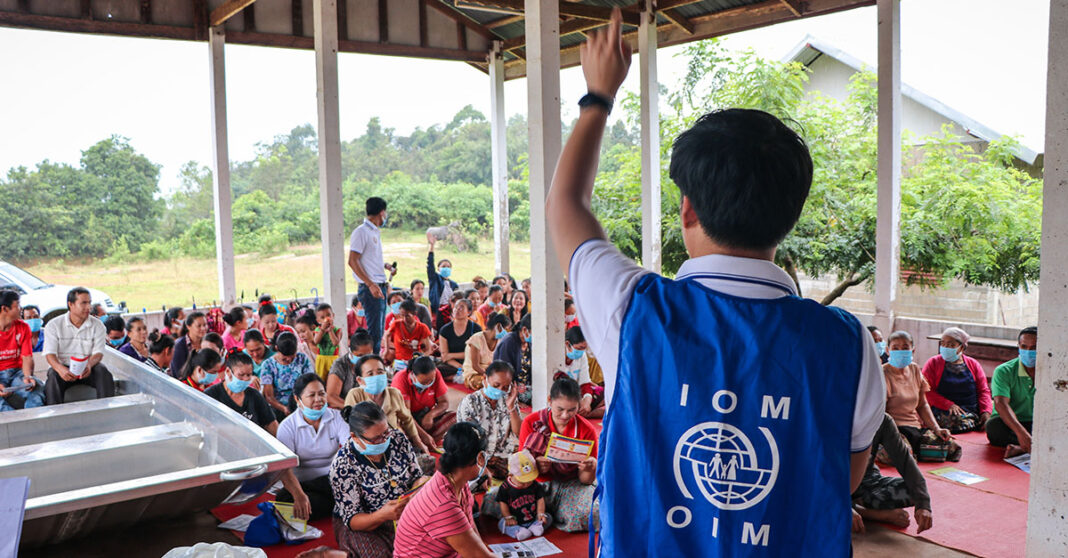Remittances have been increasingly recognized as an important source of income in Laos, particularly this year, as the country faces increased challenges from high inflation and currency depreciation.
Many institutions have demonstrated that remittances are a steady source at both individual and national level for economic stability and poverty reduction for most developing countries.
In Laos context, remittances contribute to the financial sustainability of migrant households across the country, spurring economic development and enhancing peoples’ livelihoods, especially in rural households. Specifically, remittances sent by Lao migrants serve as a crucial financial lifeline for many families, who depend on this income to carry out day-to-day activities including food security, education, healthcare, and household consumption.
In 2021, remittances accounted for over 2 per cent of the Lao national GDP amounting to USD 435 million, according to International Migration Organization’s (IOM) recent report. In fact, the total amount of remittances received is greater than the overseas development assistance (ODA) each year. The poverty rates of households receiving remittances remain much lower than non-receiving households, standing at 10.2 percent compared to 18.3 percent in 2018/19.
It was shown that poverty levels fell faster in rural areas than in towns, propelled by rising farm income and remittances, with rural poverty dropping by 7.6 percent between 2013 to 2019. Thus, indicating remittances contribute to improving the economic livelihoods of many Lao people, leading to poverty reduction in the country
At the macroeconomic level, the remittance flows to Laos provide much-needed foreign currency exchange. It also helps to stabilize the balance of payments, supplement official development assistance, contribute to public debt financing and reallocate capital resources to more productive investments. In addition, the socio-economic disruptions caused by COVID-19 call for a greater effort to well-managed migration.
Laos’s remittance inflows were disrupted during the COVID-19 pandemic. National lockdowns and factory closures in Thailand– which is the prime destination for Lao migrant workers– forced many Lao workers to return home during 2020-21, where many faced unemployment and loss of income.
The unexpected and prolonged nature of the lockdowns rendered many Lao households financially vulnerable in the absence of remittances, suggesting the need to better manage the current remittance regime in the country where remittances continue to play an instrumental role in boosting the economy.
To maximize the socio-economic benefits of remittances, it is important to establish the developmental impact of remittances to better formulate evidence-based recommendations and policies. While most remittances are spent on daily consumption activities, there is still room for this income to be channeled into more productive investments.
Remittances to Laos are still largely sent via informal channels, making it important to transform the remittance landscape for greater sustainability through comprehensive legal and regulatory mechanisms.
Improving the current system can start by sharing regional best practices; for example, the Philippines has a wealth of experience in operating an effective, large-scale remittance mechanism at a national level. Another key challenge is that the price of sending remittances to Laos ranks among the highest in Asia, adding burden for migrants sending money back home. Addressing these issues would be a crucial step towards improving remittance governance.
In 2022, Development Research Institute, Ministry of Planning and Investment, and IOM published a report ‘Remittance Landscape in Lao People’s Democratic Republic’ which outlines the initial understanding of the situation in the country. IOM is committed to assisting the Government of Laos in achieving the SDGs. The central reference to migration in the 2030 Agenda is Goal 10.7: “Reducing inequality in and among countries.”
SDG 10 specifically aims to limit the cost of migrant remittances to less than 3 percent of the total sent and eliminate remittance corridors where transaction costs are higher than 5 percent. IOM stands ready to support the government to achieve this universal goal in an effective and timely manner.
In commemoration of the International Migrants Day on 18 December, IOM is committed to facilitating orderly, safe, regular and responsible migration and mobility of people as outlined in the Global Compact for Safe, Regular and Orderly Migration (GCM).
This article has been published by Ms. Shareen TULADHAR, Chief of Mission, with support from Mr. Thanakone OUSAVANG and Mr. Dong Hyun KIM of the International Organization for Migration (IOM), to mark the contribution of migrants on the 2022 International Migrants Day.



